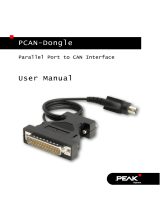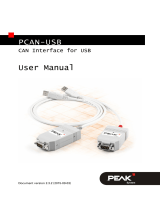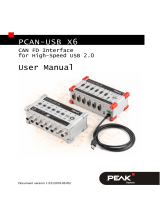Page is loading ...

Document version 2.1.0 (2017-02-09)
PCAN-Dongle
Parallel Port to CAN Interface
User Manual

PCAN-Dongle – User Manual
2
Relevant products
Product name Model Part number
PCAN-Dongle PS/2 IPEH-002019
PCAN-Dongle opto-decoupled PS/2 IPEH-002020
The cover picture shows the PCAN-Dongle opto-decoupled. The other models have a
case with silver-colored coating.
PCAN® is a registered trademark of PEAK-System Technik GmbH. CANopen® and
C
iA® are registered community trade marks of CAN in Automation e.V.
Product names mentioned in this manual may be the trademarks or registered
trademarks of their respective companies. They are not explicitly marked by “™” and
“®”.
Copyright © 2019 PEAK-System Technik GmbH
Duplication (copying, printing, or other forms) and the electronic distribution of this
document is only allowed with explicit permission of PEAK-System Technik GmbH.
PEAK-System Technik GmbH reserves the right to change technical data without
prior announcement. The general business conditions and the regulations of the
license agreement apply. All rights are reserved.
PEAK-System Technik GmbH
Otto-Roehm-Strasse 69
D-64293 Darmstadt
Germany
Phone: +49 (0)6151-8173-20
Fax: +49 (0)6151-8173-29
www.peak-system.com
info@peak-system.com
Doc
ument version 2.1.0 2019-03-05

PCAN-Dongle – User Manual
3
Contents
1 Introduction 4
1.1 Properties at a Glance 4
1.2 System Requirements 5
1.3 Scope of Supply 6
2 Software and Hardware Installation 7
3 Connecting a CAN Bus 10
3.1 Connection over D-Sub connector 10
3.2 Voltage Supply for External Devices 11
3.3 Cabling 13
4 Operation 15
4.1 Prerequisites for the Operation 15
4.2 Interface Information 16
4.3 Operating Modes 18
5 Software and API 19
5.1 Monitor Software PCAN-View 19
5.2 Linking Own Programs with PCAN-Basic 26
6 Frequently Asked Questions (FAQ) 30
7 Technical Specifications 31
Appendix A CE Certificate 33
Appendix B Quick Reference 34

PCAN-Dongle – User Manual
4
1 Introduction
This parallel connection to CAN converter is a sensible alternative to
using a PCAN-USB adapter for connecting to a CAN network,
especially for older PCs and laptops. Depending on the parallel
interface present, it can be operated in "Multiplex" or "Enhanced
Parallel Port" mode. Power is supplied to the PCAN-Dongle through
a special adapter connected to the PC's keyboard output.
The opto-decoupled version also guarantees galvanic isolation of
up to 500 Volts between the PC and the CAN sides.
The monitor software PCAN-View and the programming interface
PCAN-Basic for the development of applications with CAN
connection are included in the scope of supply.
Device drivers exist for different operating systems, so programs
can easily access a connected CAN bus.
Note: This manual refers to both the PCAN-Dongle standard
model as well as the one with galvanic isolation. Differences at
use and at the technical specifications are mentioned
accordingly in this manual.
Tip: At the end of this manual (Appendix B) you can find a
Quick Reference with brief information about the installation
and operation of the PCAN-Dongle.
1.1 Properties at a Glance
Logic control by means of integrated CPLD
Supplied in space-saving port adapter casing D-Sub 25-pin (LPT)
to D-Sub 9-pin (CAN)

PCAN-Dongle – User Manual
5
Software-driven switching from “Multiplex” to “EPP (Enhanced
Parallel Port)” mode
The voltage supply is through the PS/2 keyboard connection
High-Speed CAN connection (ISO 11898-2)
Bit rates from 5 kbit/s up to 1 Mbit/s
Compliant with CAN specifications 2.0A (11-bit ID)
and 2.0B (29-bit ID)
CAN bus connection via D-Sub, 9-pin
(in accordance with CiA® 303-1)
NXP SJA1000 CAN controller, 16 MHz clock frequency
NXP PCA82C251 CAN transceiver
5-Volt supply to the CAN connection can be connected through a
solder jumper, e.g. for external bus converter
Galvanic isolation on the CAN connection up to 500 V
(only opto-decoupled model)
Operating temperature range from 0 to 60 °C (32 to 140 °F)
Note: This manual describes the use of the PCAN-Dongle with
Windows. You can find device drivers for Linux and the
corresponding information on PEAK-System's website under
www.peak-system.com/linux.
1.2 System Requirements
A free parallel port (D-Sub, 25 pins) at the computer, capable of
interrupts
Operating system Windows 10, 8.1, 7 (32-bit) or Linux (32/64-bit)

PCAN-Dongle – User Manual
6
1.3 Scope of Supply
PCAN-Dongle in plastic casing
Device drivers for Windows 10, 8.1, 7 (32-bit) and
Linux (32/64-bit)
CAN monitor PCAN-View for Windows
CAN monitor PCAN-View for DOS
Programming interface PCAN-Basic for developing applications
with CAN connection
Programming interfaces for standardized protocols from the
automotive sector
Manual in PDF format

PCAN-Dongle – User Manual
7
2 Software and Hardware
Installation
This chapter covers the software setup for the PCAN-Dongle under
Windows.
Install the driver before
you install the adapter.
Do the following to install the driver:
1. Start Intro.exe from the supplied DVD.
The navigation program starts.
2. Select in the main menu Drivers and click on Install now.
3. Confirm the message of the User Account Control related to
"Installer database of PEAK Drivers".
The driver setup starts.
4. Follow the program instructions until the Costum Setup is
displayed.
Figure 1: Driver selection in the PEAK-Drivers Setup

PCAN-Dongle – User Manual
8
5. Deselect the CAN device drivers and select CAN device
drivers Non-Plug-and-Play.
Node: The CAN device drivers Non-Plug-and-Play is only
available under 32-bit Windows. PCAN-Dongle does not work
under 64-bit Windows.
6. Follow the further instructions.
Do the following to install the adapter:
1. Turn off the computer.
2. Connect the PCAN-Dongle with the wider port (25 pins) to
the free parallel port at the computer.
3. Pull the keyboard connector from the corresponding port at
the computer.
4. Connect the T-piece at the cable of the PCAN-Dongle to the
keyboard port.
5. Reconnect the keyboard to the free end of the T-piece.
A configuration of the hardware is not needed. However, you
should check the settings for the parallel interface in the computer's
BIOS setup.
If the computer has a parallel interface with EPP as well as ECP
properties, the corresponding setting in the BIOS set-up should be
ECP (not EPP and not EPP+ECP). Although the extended properties
of the PCAN-Dongle usually will work with the last-mentioned
setting, some systems may have problems with it. Therefore the
setting for the “pure” ECP mode should be preferred.
Further information about the different operating modes of the
PCAN-Dongle can be found in section 4.3.

PCAN-Dongle – User Manual
9
Do the following to install the adapter:
After turning on the computer, the LED at the PCAN-Dongle must
light red. This indicates that the power supply for the PCAN-Dongle
is correct.
Attention! Don't remove PCAN-Dongle from the computer
while powered on (red LED on PCAN-Dongle is lit). Electronic
parts of the PCAN-Dongle or the computer's parallel interface
may be harmed.

PCAN-Dongle – User Manual
10
3 Connecting a CAN Bus
3.1 Connection over D-Sub connector
A High-speed CAN bus (ISO 11898-2) is connected to the 9-pin
D-Sub connector. The pin assignment corresponds to the
specification CiA® 303-1.
Figure 2: Pin assignment High-Speed CAN
(view onto connector of the PCAN-Dongle)
Low power devices (e.g. bus converters) can be supplied directly
with 5 volts over pin 1 and/or pin 9 of the CAN connector. Pin 1
and/or pin 9 are not in use at the delivery state. For more
information see the next section 3.2.
Tip: You can connect a CAN bus with a different transmission
standard via a bus converter. PEAK-System offers different bus
converter modules (e.g. PCAN-TJA1054 for a Low-speed CAN
bus according to ISO 11898-3).

PCAN-Dongle – User Manual
11
3.2 Voltage Supply for External Devices
External devices with low power consumption (e.g. bus converters)
can be directly supplied via the CAN connector. With a solder bridge
on the PCAN-Dongle board (casing opened), a 5-Volt supply can
optionally be routed to pin 1 and/or pin 9 of the D-Sub connector
(PCAN-Dongle opto-decopled: pin 1 only).
The opto-decoupled model of the Dongle contains an
interconnected DC/DC converter. Therefore, the current output is
limited to about 50 mA.
Do the following to activate the voltage supply:
Risk of short circuit! Solder with great care to avoid unwanted
short circuits on the board.
Attention! Electrostatic discharge (ESD) can damage or destroy
components on the board. Take precautions to avoid ESD.
1. Open the case of the PCAN-Dongle by cautiously
levering
the latches on both sides, e.g. with a flat tip screwdriver.
2. Remove the board.
3. Set the solder bridge(s) on the PCAN-Dongle board
according to the desired settings.
Figure 3 shows the position of the solder bridge JP9.
Figure 4 shows the position of the solder bridges R11.
The
tables below contain the possible settings.
4. For reassembly, place the board overhead onto the top part
of the case.
Make sure that the cable is lying in the side cut-out with the
strain relief inside the case, and that the LED is placed in the
corresponding hole of the top part of the case.

PCAN-Dongle – User Manual
12
5. Push the bottom part of the case onto the top part until the
latches click in.
Figure 3: PCAN-Dongle (bottom view)
5-Volt supply
D-Sub connector
Solder field
Without
(Standard)
Pin 1 Pin 9 Pin 1 and
pin 9
CAN 1 JP9
Figure 4: PCAN-Dongle opto-decoupled (top view)
5-Volt supply
D-Sub connector
Solder field
Without
(Standard)
Pin 1
CAN 1 R11

PCAN-Dongle – User Manual
13
3.3 Cabling
3.3.1 Termination
The High-speed CAN bus (ISO 11898-2) must be terminated with
120 ohms at both ends. The termination prevents interfering signal
reflections and ensures the proper operation of the transceivers of
the connected CAN nodes (CAN interfaces, control devices).
The PCAN-Dongle adapter does not have an internal termination.
Use the adapter on a terminated bus.
3.3.2 Example of a Connection
Figure 5: Simple CAN connection
This example shows a connection between the PCAN-Dongle
adapter and a control unit. The connection cable is terminated with
120 ohms at both ends.

PCAN-Dongle – User Manual
14
3.3.3 Maximum Bus Length
High-speed CAN networks have bit rates up to 1 Mbit/s. The
maximum bus length primarily depends on the bit rate.
The following table shows different maximum possible CAN bus
length with different bit rates:
Bit rate Bus length
1 Mbit/s 40 m
500 kbit/s 110 m
250 kbit/s 240 m
125 kbit/s 500 m
50 kbit/s 1.3 km
20 kbit/s 3.3 km
10 kbit/s 6.6 km
5 kbit/s 13.0 km
The listed values have been calculated on the basis of an idealized
system and can differ from reality.

PCAN-Dongle – User Manual
15
4 Operation
4.1 Prerequisites for the Operation
Under Windows you must explicitly determine the use of an
interrupt for the parallel interface. This is done in the Windows
Device Manager.
Do the following to assign an interrupt to the parallel interface
under Windows:
1. Open the Windows Device Manager.
2. Under Ports (COM & LPT) in the tree view of the Device
Manager double click on the entry Printer Port (LPTx) or ECP
Printer Port (LPTx).
Figure 6: Entry in the Device Manager for the printer port
3. Select the tab Port Settings.
4. Activate the option Use any interrupt assigned to the port.

PCAN-Dongle – User Manual
16
Figure 7: Indicating the use of an interrupt
4.2 Interface Information
For the initialization of the PCAN-Dongle during the start of an
application you need information about the used interrupt and port
address of the parallel interface.
Do the following to find out the interrupt and the I/O range used
by the parallel interface:
1. Open the Windows Device Manager.
2. Under Ports (COM & LPT) in the tree view of the Device
Manager double click on the entry Printer Port (LPTx) or ECP
Printer Port (LPTx).
Figure 8: Entry in the Device Manager for the printer port

PCAN-Dongle – User Manual
17
3. Select the tab Resources.
4. From the entries I/O Range (first value = port address) and
Interrupt or IRQ in the list you can see the needed
information. Write down this information for later use.
Figure 9: Resource information about the parallel interface

PCAN-Dongle – User Manual
18
4.3 Operating Modes
The PCAN-Dongle can be used in one of four possible operating
modes:
Name of operating
mode
Alternative
identifier
Description
Multiplex Mode PEAK Dongle-CAN Standard Parallel Port (SPP)
EPP Mode PEAK Dongle-CAN
EPP
Extended Capability Port (ECP)
Multiplex PeliCAN
Mode
PEAK Dongle-CAN
SJA
Standard Parallel Port (SPP),
extended CAN functionality (CAN
2.0B incl. 29-bit IDs)
EPP PeliCAN Mode PEAK Dongle-CAN
SJA EPP
Extended Capability Port (ECP),
extended CAN functionality (CAN
2.0B incl. 29-bit IDs)
The EPP PeliCAN Mode is recommended to gain the full CAN
functionality at lowest possible computer system load. If this mode
doesn't work correctly, you can fall back to one of the other
operating modes. The Multiplex Mode should work on any system.
Tip: You can find further information about the PeliCAN Mode
in the data sheet for the CAN controller SJA1000 by NXP
obtainable at the according website, for example.
You can find information about activating an operating mode in the
following section.

PCAN-Dongle – User Manual
19
5 Software and API
This chapter covers the provided software PCAN-View and the
programming interface PCAN-Basic.
5.1 Monitor Software PCAN-View
PCAN-View is simple Windows software for viewing, transmitting,
and logging CAN and CAN FD messages.
Note: This chapter describes the use of PCAN-View with a CAN
adapter.
Figure 10: PCAN-View for Windows

PCAN-Dongle – User Manual
20
Do the following to start and initialize PCAN-View:
1. Open the Windows Start menu and select PCAN-View.
The Connect dialog box appears.
Figure 11: Selection of the hardware and parameters
2. Select an interface from the list and continue with step 6.
3. If no entry
is in the list, press the button Add. The dialog box
Add CAN hardware appears.
If the mode of the parallel interface is set to ECP in the
computer's BIOS setup, you can register the PCAN-Dongle
as PEAK Dongle-CAN SJA EPP.
4. Enter the port address and the interrupt of the used parallel
interface established before (see section 4).
/







